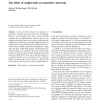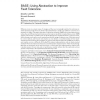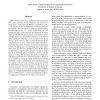101 search results - page 6 / 21 » On the Fault Tolerance of Some Popular Bounded-Degree Networ... |
NCA
2011
IEEE
13 years 2 months ago
2011
IEEE
In the past three decades, the properties of associative networks has been extensively investigated. However, most existing results focus on the fault-free networks only. In implem...
FGCS
2002
13 years 7 months ago
2002
Initial versions of MPI were designed to work efficiently on multi-processors which had very little job control and thus static process models. Subsequently forcing them to suppor...
IPPS
1998
IEEE
13 years 12 months ago
1998
IEEE
In this paper the problem of fault-tolerant message routing in two-dimensional meshes, with each inner node having 4 neighbors, is investigated. It is assumed that some nodes/links...
SOSP
2001
ACM
14 years 4 months ago
2001
ACM
ing Abstraction to Improve Fault Tolerance MIGUEL CASTRO Microsoft Research and RODRIGO RODRIGUES and BARBARA LISKOV MIT Laboratory for Computer Science Software errors are a major...
DSN
2005
IEEE
14 years 1 months ago
2005
IEEE
Fault-tolerant protocols, asynchronous and synchronous alike, make stationary fault assumptions: only a fraction f of the total n nodes may fail. Whilst a synchronous protocol is ...



